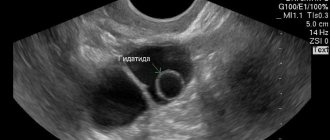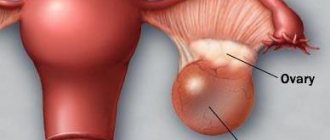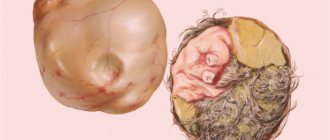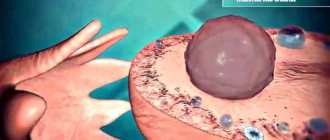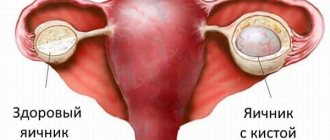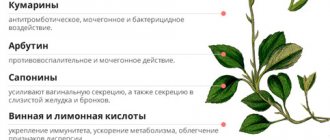Ovarian cyst is a common pathology among women of childbearing age. Some of its types are relatively safe and can disappear on their own after several menstrual cycles. However, there are types of cystic formations that tend to grow rapidly. They can lead to serious complications, including torsion of an ovarian cyst. This condition is highly life-threatening and requires immediate medical attention.
The essence of pathology
An ovarian cyst is a cavity in which there is liquid content ; it is attached to the ovary using a stalk - long or short .
The size of the neoplasm can reach 20 cm in diameter.
Cysts are divided into two groups - functional and organic.
Functional cysts develop against the background of hormonal disorders, and when hormonal balance is restored, they can resolve on their own.
Organic cysts do not respond well to drug treatment and never disappear on their own. They are usually removed surgically.
Functional cysts:
- follicular;
- Corpus luteum cyst.
Organic:
- endometrioid;
- dermoid;
- paraovarian;
- mucinous;
- serous.
NOTE!
Some types of cysts can transform into cancer, but in most cases they are benign neoplasms.
Cysts are most often diagnosed in women of childbearing age, but can sometimes occur in other age groups.
In rare cases, congenital cysts (for example, dermoid) can be diagnosed even in newborn girls.
In the absence of adequate therapy, cystic neoplasms can become complicated .
Large cysts are prone to rupture; in addition, they can twist, which leads to pinching of blood vessels. These complications are considered very dangerous and require urgent medical intervention.
Forecast
With early diagnosis and treatment, the health prognosis is favorable. The tissue of the appendage can be preserved, and in the future they function normally.
p, blockquote 34,0,0,0,0 —>
However, in most patients, the diagnosis of ovarian torsion is made late, which often leads to necrosis. Therefore, the incidence of adnexal preservation is only 10% in adults and 27% in children.
p, blockquote 35,0,0,0,0 —>
Losing one ovary usually has little impact on a woman's ability to conceive, and mortality from the condition is minimal. However, early laparoscopy allows for more gentle treatment and prevents possible complications.
p, blockquote 36,0,0,0,0 —>
Recurrent torsion occurs in 19.5% of pregnant women with this diagnosis and 9% of non-pregnant women who have had this disease.
p, blockquote 37,0,0,0,0 —>
p, blockquote 38,0,0,0,0 —>
What is torsion?
Pathology code according to ICD-10 No. 83.5.
Cyst torsion is a surgical complication that occurs when the pedicle is twisted, which provokes necrotic changes in the tissues.
In addition, the veins of the leg are pinched, the outflow of blood is disrupted, the size of the cyst increases, and, consequently, the risk of rupture of the tumor increases.
Torsion can be of the following types:
- Full . In this case, the neoplasm makes a full revolution around its axis, the blood supply stops, and the clinical picture is very acute.
- Partial bending of the leg . The leg moves no more than 90 degrees, the blood supply deteriorates, but does not stop. The symptoms are not pronounced. The surface of the cyst synthesizes a certain substance that promotes the attachment of the cyst to other organs. The bend stops progressing, but the cyst quickly increases in size, which threatens to rupture.
The pedicle of the cyst can be surgical or anatomical.
With an anatomical pedicle, it includes elements that are in close contact with the ovary - organ ligaments, mesentery, nerves, lymphatic and blood vessels.
The surgical leg is formed precisely at the moment of torsion. Regarding the speed of development of the pathology, torsion can be gradual and acute.
The mechanism of development of the pathology is a sharp or gradual compression of the veins (the arteries are not affected).
As a result, venous blood stagnates, and this can lead to hemorrhage or rupture of the tumor. The cyst becomes bluish or purple.
Which species are prone to twisting?
Torsion of the cyst pedicle may not occur in all types of cysts . For example, follicular cysts and corpus luteum cysts very rarely lead to such a complication.
These neoplasms are not large in size and are not prone to increased mobility.
The following types of cysts are most often twisted::
- dermoid;
- ovarian;
- paraovarian;
- mucinous.
The process may involve the elements that make up the stalk of the neoplasm. In addition, it is possible that the intestines and fallopian tubes are involved in the process.
CAREFULLY!
The more elements and organs are involved in torsion, the more dangerous the complication is considered.
Symptoms and manifestations
The clinical picture of torsion is always clear.
There is a sharp pain that constantly intensifies, and in severe cases it can lead to the woman being unable to even move . Sometimes the pain can radiate to the upper abdominal cavity, and even to the upper and lower extremities.
- Vegetative disorders - increased sweating, pale skin, vomiting, increased heart rate, decreased blood pressure, increased temperature, rapid breathing.
- Problems with stool.
- Drying of the mucous membranes of the mouth, constant unquenchable thirst, which is due to the fact that a large amount of fluid is removed from the body along with sweat and urine.
- Increased gas formation.
- Vaginal bleeding, which occurs not only due to torsion, but also due to damage to organ tissue.
- Increased urination, this phenomenon is especially often observed when the cyst is torsioned in the immediate vicinity of the bladder.
- Hard belly syndrome is an involuntary tightening of the abdominal muscles.
If the leg is partially bent, the clinical picture will be less clear, however, after some time the signs of torsion will be stronger.
It is necessary to understand that after a couple of hours a woman begins to experience necrotic changes in the tissues, while the pain becomes weaker and then goes away completely.
This phenomenon is considered extremely dangerous, and if a woman is not provided with emergency medical care, she will develop peritonitis, which often causes the patient’s death.
Symptoms
The clinical picture of torsion is individual and depends, first of all, on the degree of torsion of the leg and the speed of development of the pathological process. With complete torsion, the symptoms resemble those of an “acute abdomen.” These include:
- The occurrence of sharp pain in the area of the abdomen in which the pathological process occurs (it can radiate to the leg or sacrum).
- Change in skin color - they become pale.
- Sudden onset of nausea, which is accompanied by vomiting.
- Appearance of sticky cold sweat on the skin.
- A sharp increase in body temperature.
- Increased heart rate.
- Signs of hypotension.
- Intestinal dysfunction, which manifests itself in the form of constipation, diarrhea, flatulence, etc.
- Frequent urge to urinate, most of which are false.
This clinical picture is complemented by overstrain of the abdominal wall. When pressing on it, the woman experiences increased pain.
Important! With complete torsion, necrosis begins to develop after 2-3 hours. It is accompanied by a decrease in pain or its complete disappearance, which is caused by the death of nerve endings. However, in no case should a woman be happy with this condition, since if she does not receive timely medical care, peritonitis occurs 3-5 hours after the development of necrosis, which in most cases leads to death.
With incomplete torsion, a blurred clinical picture is observed. Symptoms may occur one after another, gradually increasing in intensity.
Causes
Torsion of the cyst pedicle can occur under the influence of the following factors::
- a sharp increase in intra-abdominal pressure, which is possible during heavy physical activity;
- excessive straining during bowel movements;
- failure in the hormonal system;
- sharp and prolonged cough;
- ascites – accumulation of fluid in the abdominal cavity;
- sudden change in body position.
Quite often, torsion of the pedicle of a neoplasm is observed during pregnancy..
Most often, neoplasms with a long stalk are twisted.
Torsion of ovarian cyst: diagnosis and treatment
The diagnosis of torsion of a tumor-like formation of the ovary is established on the basis of the presence of characteristic complaints of the patient, data from the medical history and disease, the results of an objective examination and gynecological examination of the woman in a chair and additional research methods.
During ultrasound diagnostics, an ovarian cyst is defined as a round formation measuring up to 7-10 cm in diameter with blurred contours and a thickened capsule. Only diagnostic laparoscopy will provide complete information about the nature of the pathology. An endoscopic examination reveals a purple-cyanotic node in the pelvic cavity and the presence of serous-hemorrhagic fluid in the abdominal cavity.
In the treatment of torsion of the pedicle of an ovarian tumor, only emergency surgical intervention is indicated. Literally, a couple of years ago, when the leg was bent, specialists all over the world used active treatment tactics: they performed adnexectomy using a laparotomic approach. In this case, the leg was cut off without preliminary untwisting, fearing that blood clots formed in it could enter the general bloodstream and cause thromboembolism.
With the development of modern technologies, organ-saving operations using laparoscopy have become increasingly used. Since during laparoscopy it is impossible to assess the internal structure of the tumor without compromising its integrity, the use of intraoperative ultrasound is recommended. At the slightest suspicion of malignancy, they proceed to laparotomy.
The Yusupov Hospital has all the best qualities of European medicine. Only in an oncology clinic does a patient undergo examinations and receive results on the same day, without delaying the start of treatment for many days or even weeks. The patient can always receive professional psychological help at any stage of therapy. Unique rehabilitation programs will allow the patient to restore lost body functions in the shortest possible time and return the patient to a full life. To make an appointment and consultation, please call.
What is the danger?
The danger of torsion in the development of even more negative consequences:
- tissue necrosis;
- breakthrough internal bleeding into the ovary;
- rupture of a cyst with leakage of contents into the abdominal cavity;
- peritonitis;
- fusion of the cyst with organs located nearby;
- development of the adhesive process.
Expert opinion
Dmitrieva Elena Yurievna
Gynecologist-endocrinologist, 40 years of experience
Torsion of the ovarian pedicle is an acute condition in which a woman must be urgently hospitalized. In this case, attacks of pain do not stop, but only intensify. With a decrease in pain, the woman believes that the danger has passed and is in no hurry to see a doctor, and this is by no means a favorable sign, but, on the contrary, indicates an even more serious complication. The cyst cavity ruptures and all its contents spill into the abdominal cavity. This phenomenon provokes peritonitis, a complication that is deadly. Every woman should clearly understand that torsion of the cyst stalk is dangerous, and if the above clinical signs are present, immediately call an ambulance.
Diagnosis of the disease
Initially, diagnosis begins with palpation of the patient's abdomen. Peritoneal tension and peritoneal signs are observed.
In addition, they are appointed:
- Blood test - ESR increases and leukocytosis increases.
- Gynecological examination in a chair - the presence of a neoplasm in the adnexal zone is determined, which, when trying to move it to the side, provokes severe pain. In some cases, the chairside examination is so painful that it is performed under anesthesia.
- Ultrasound. The contours of the cyst are blurred, the capsule is thickened, and a double contour may be observed, which indicates edema. There is effusion in the pelvis.
- Laparoscopic diagnosis. Endoscopic examination reveals a purple node, the fluid is serous or serous-hemorrhagic.
Pathology must be differentiated from:
- renal colic;
- inflammation of the appendix;
- ectopic pregnancy;
- salpingo-oophoritis.
Treatment methods
Treatment of pathology is only surgical.
Alternative treatment measures do not provide positive results, and delay can further complicate the situation.
The main task of the surgeon is to restore blood flow and normal condition of the ovary. If tissue necrosis occurs, the appendage is completely removed.
If ovarian torsion is uncomplicated, laparoscopic intervention is performed . In this case, the neoplasm unwinds and is removed.
With the development of peritonitis, abdominal intervention is necessary - laparotomy, in this case the ovary is completely removed.
If an oncological process is suspected, an emergency examination of a tissue sample is carried out, after which complete removal of all reproductive organs is possible.
As for preventive measures to prevent possible torsion of the pedicle of a cystic neoplasm, regular examination by a gynecologist is necessary.
If a small cystic formation is diagnosed and the doctor decides to monitor the pathological process, the patient should come for a preventive examination at the frequency prescribed by the doctor.
As soon as active growth of a neoplasm is suspected, it must be treated with conservative methods or removed, since the risk of torsion in this case increases sharply.
Prevention
To prevent the development of complications, experts recommend following simple preventive measures:
- Regularly visit a gynecologist and undergo an ultrasound.
- Carefully observe formations when diagnosing them.
- Get timely treatment.
- Eliminate the influence of stress and excessive physical activity.
Compliance with preventive measures will avoid the development of complications.

